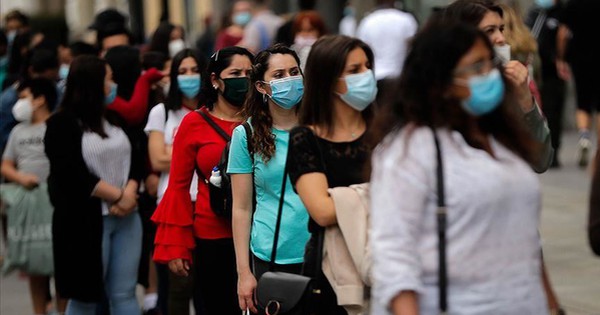The world entered the “post-pandemic” Covid-19?
According to Reuters news agency, the European Commission has just announced that 60%-80% of the population of the European Union (EU) has been infected with Covid-19, in the context that the bloc has officially entered the “post-emergency” phase of the pandemic. Epidemic: Member countries will not need to report new cases, Covid-19 will be monitored like influenza. This means that community testing even in people with symptoms will be abolished in some EU countries, leaving only surveillance testing in priority groups.
The EU’s public health agency says reported cases make up about 30 per cent of the population, but if you add unreported cases, the figure would be around 77 per cent, or 350 million people. However, the number of deaths gradually decreased as Omicron was less virulent than previous widespread strains. 70% of the EU population has also been vaccinated against Covid-19, with 50% getting a booster shot.

Gorgeous dancers on the second night of the Carnival ball in Rio de Janeiro – Brazil on April 24 Photo: REUTERS
In many Latin American countries, once hard-hit areas with Brazil and Peru among the group with the highest number of Covid-19 deaths in the world, restrictive measures have also been eased. Going forward, Colombia will remove the requirement to wear masks in many public areas, including cinemas; Chile opens the border after 2 years “closed the gate high wall”; The President of Mexico announced the pandemic was over… Carnival street dance jubilantly on the streets of Rio de Janeiro – Brazil this midweek with more than 60,000 attendees also did not have to wear masks.
Most countries in Latin America have achieved WHO-recommended vaccination rates above 70%. The number of cases and deaths in April 2022 almost fell to the level of the first 2 months when the pandemic occurred. For example, in Peru, from 200 deaths a day in February, it dropped to about 20 deaths a day by the end of April. Some experts believe that thanks to vaccinations and months of struggling with many strains of SARS-CoV- 2, the area is resistant to new waves of epidemics, including those caused by the BA.2 strain that is making waves.
During a press conference on April 26, the new White House Covid-19 Coordinator – Dr. Ashish K.Jha – stated that the US is no longer seeking to prevent all transmission routes, but focuses on a strategy to protect the virus. risk figure. Although the number of new cases in the US is increasing, the number of deaths has continuously decreased. Statistics from the US Centers for Disease Control and Prevention (CDC) also show that 58% of the country’s population has been infected with Covid-19, especially children infected up to 3/4.
The New York Times quoted Dr. Jha as saying that the important thing is whether the health system is overwhelmed and the number of hospitalizations / deaths is more or less. Therefore, access to vaccines and advanced treatments, including antivirals like Pfizer’s Paxlovid, is paramount. Similarly, the EU’s “post-emergency” strategy – drafted by Health Commissioner Stella Kyriakides – also targets two spears: new-generation antiviral drugs and vaccines, improved to be more relevant to immune escape mutations.
However, the individual policies of each country only make sense to a limited extent. It is the World Health Organization (WHO) that is responsible for declaring a pandemic and ending it as a move that has broad legal implications in many areas. The most recent WHO report on April 26 showed that the number of global Covid-19 deaths in the previous week had dropped to the lowest level since March 2020. However, the organization still urges countries to be cautious and maintain a Covid-19 surveillance system, including testing and sequencing the SARS-CoV-2 genome.
Pay attention to other diseases
The number of measles cases globally increased by 79% in the first two months of this year compared with 2021, after the Covid-19 pandemic and lockdown disrupted vaccination campaigns. Specifically, according to data from UNICEF and WHO, in January and February 2022, up to 17,338 cases of measles were recorded in the world, compared with 9,665 cases in the same period last year.
An extremely dangerous infectious disease, especially for young children, measles spreads faster than Ebola, flu or Covid-19. In the past 12 months, there have been 21 major measles outbreaks, the most serious in five countries, Somalia, Liberia, Yemen, Afghanistan and Ivory Coast, according to Reuters.
As of early April, 58 immunization campaigns in 43 countries were still delayed, affecting 212 million people, mostly children. Of these, 19 are vaccinated against measles and as a result 73 million children are at risk, according to UNICEF and WHO.
Causing much concern is hepatitis of unknown origin, which has spread to more than 10 countries. To date, 190 cases of this disease have been recorded, of which 140 cases are in Europe (mostly in the UK with 110 cases) and more cases in Israel, the US, Canada… There are 17 children with serious illness up to level of need for a liver transplant and WHO reported at least one infant death. The disease is also present in Asia, with one case reported in Japan on April 21. This patient tested negative for the adeno virus – a possible cause of the disease under global scrutiny – and Covid-19, according to the Guardian.
It is noteworthy that the pediatric patients – according to WHO, children from 1 month to 16 years old – did not have hepatitis viruses and had no underlying disease. According to the British health agency, one theory is that children are not exposed to the adeno virus, which often causes colds and intestinal upset, during the Covid-19 pandemic, leading to more severe illness in children.
sea Pearl
at Blogtuan.info – Source: nld.com.vn – Read the original article here



